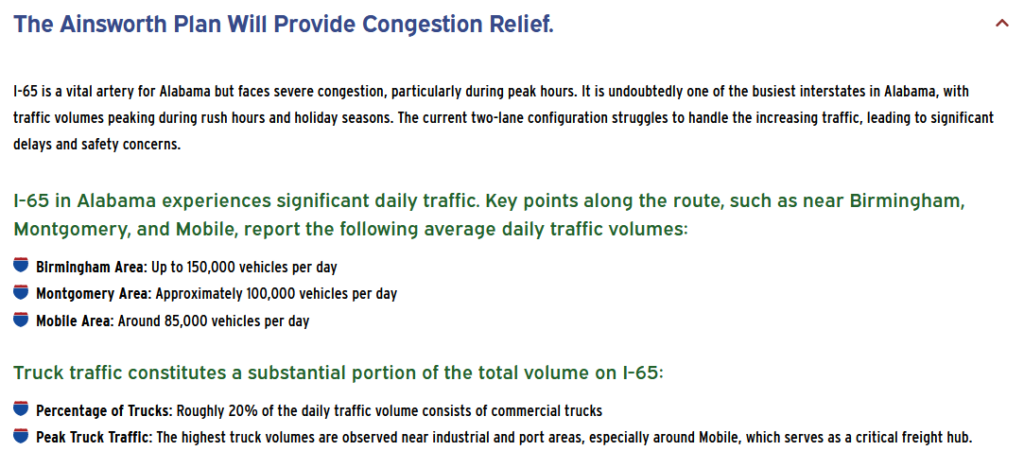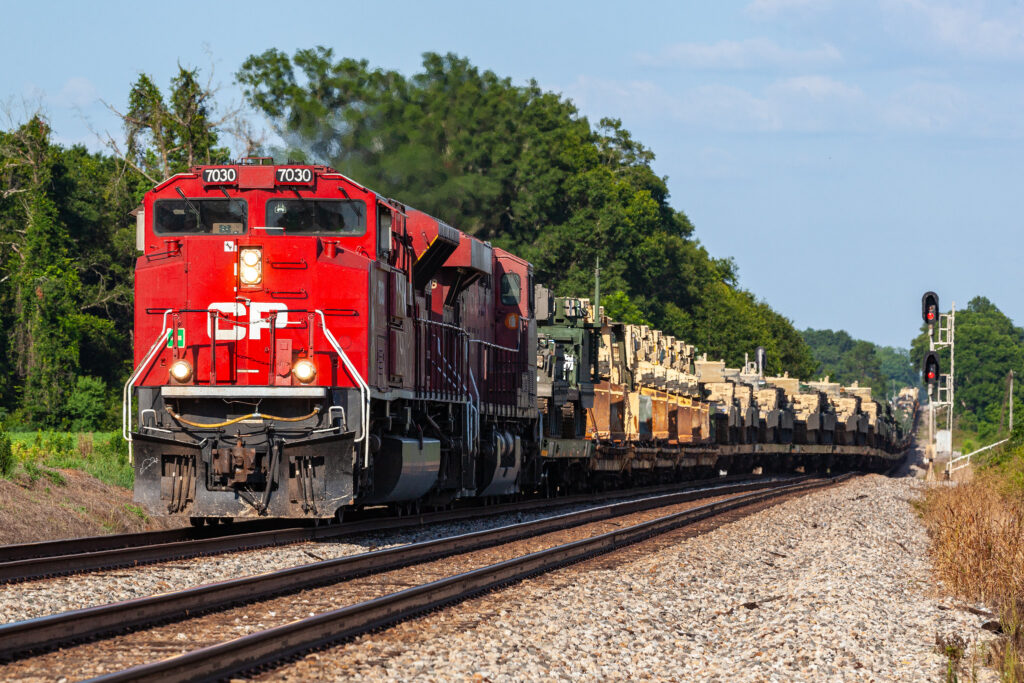So if you’ve taken a trip on I-65 through Alabama recently, you’ve no doubt encountered billboards from the so-called “I-65 Coalition” urging motorists to “Go Wide!” and to support the “Ainsworth Plan” to add an extra lane to I-65 on its entire length in the state. The group, led by George Clark of industry lobby group Manufacture Alabama, makes several claims to make the case that road widening is a good idea. I’ve already written quite a lengthy post explaining in detail why that’s false, but let’s go through George & Will’s plan point by point.
1. The Ainsworth Plan Will Provide Congestion Relief.

Widening Roads Does Not Relieve Traffic. This has been studied and borne out since the 1960s, in areas across the nation and even the world. In fact, to quote this study published in the scientific journal Transport Policy in 2019, “highway capacity expansion generates an exactly proportional increase in vehicle travel” and in fact “induced vehicle travel is expected to revert traffic speeds to pre-expansion levels in approximately five years.” (Emphasis mine.) So if I-65 is widened to include an additional lane as George & Will suggest, there will be enough extra traffic to fill that new lane just 5 years after it opens.
So what if, instead, the ADECA Passenger Rail Studies were implemented?
George & Will claim that I-65 sees up to 150,000 vehicles per day around Birmingham, the most traffic of the 3 “key areas” they cite. Using the Federal Highway Administration’s Average Vehicle Occupancy factor of 1.7 persons/vehicle, we see that about 255,000 people are using I-65 in its busiest region.
Below is a chart taken from the ADECA Birmingham-to-Montgomery rail study. Alternative 3, the option I used for my calculations in my Open Letter, would have an estimated ridership of at least 316,650 people. That is significantly above even the busiest section of I-65. So I feel comfortable in saying that passenger rail would in fact actually decrease congestion, rather than just adding a new lane to be filled up in a few years.

Let’s look at George & Will’s other claims.
2. The Ainsworth Plan Will Lead To Substantial Economic Growth.

George & Will didn’t provide any numerical evidence for this claim, so I will. According to the American Public Transportation Association, every $1 invested in high-speed rail creates $4 in economic benefits, and every $1 billion invested creates 24,000 well-paying, steady jobs. According to the Rail Passengers Association (RPA), Amtrak’s Crescent (currently the only passenger train that serves Alabama) returns $232.8 million for an investment cost of $33.7 million–a return on investment of nearly seven-to-one. The same source indicated a similar ROI for a second daily train between Chicago and Minneapolis/St. Paul, and Amtrak launched the service in May of this year (2024). In its first month of operation, it already generated more than enough revenue to cover the train’s operating expenses, a fact which surprised even Amtrak themselves.
Closer to home, the RPA also calculated that rail service between Mobile & New Orleans, would generate over $19 million in total economic output for the state of Alabama, while costing the state $8.3 million. And this is for a service with fewer than 40 miles in the state–imagine the benefits of a line connecting Alabama’s most important cities!
Finally, according to a 2019 report, Alabama’s roads are so congested and dangerous that it costs Alabamians $3.3 billion every year in fuel, time, and lives lost. The ADECA studies project the cost of rail service as less than $2 billion to construct and operate for 15 years, with total direct revenue from ticket sales over that same period of at least $135 million. George & Will’s highway widening plan will not only cost more over those same 15 years, but–as mentioned earlier–traffic will have increased enough to fill that new lane three times over. Is the cost really worth it?
3. The Ainsworth Plan Will Lead to Increased Tourism

Again, very scanty on the sources here, but they claim that widening I-65 will provide “easier access” to tourist attractions. Notwithstanding the fact that, since Widening Roads Does Not Relieve Traffic, highway access will actually remain largely the same, I wonder what tourist attractions George & Will could mean here? For instance, the Equal Justice Initiative’s Legacy Museum is located in the heart of downtown Montgomery, a mere few blocks from well-preserved Union Station (which would serve as Montgomery’s train station in the ADECA studies) and easily reached from there on foot. Couple this with the fact that walkable places are vastly more productive, and the fact that most other popular tourist destinations are within walking distance of the proposed train stations in the ADECA studies, I don’t see how a 70-mile-an-hour highway could be more accessible for tourism than walking off the train and right into a neighboring shop.
4. The Ainsworth Plan Will Lead to Significant Safety Improvements

The last point here is actually completely false. The Federal Highway Administration lists the 5 crucial elements of safe public roads:
- Safe Road Users
- Safe Vehicles
- Safe Speeds
- Safe Roads
- Post-Crash Care
Adding a lane to I-65 would not only not address any of these factors, it would actually make some of them worse. Wider lanes make people want to drive faster, and “improved traffic flow” means that there would be much more space to reach dangerous speeds as well as less visual input to encourage drivers to continually pay attention to the road. Two of the most common causes of car accidents are excessive speed and distracted driving; wider lanes and improved traffic flow mean higher speeds and fewer distractions, so this is a recipe for more accidents, not fewer.
5. The Ainsworth Plan Will Improve Quality of Life

As I’ve shown above, traffic on I-65 will return to pre-expansion levels within 5 years. This means that travel times might see a brief dip, but would quickly return to current times. Accessibility would not materially improve, for the same reason. And I have to just laugh at the lip service George & Will paid to public transportation…sure, this expansion can “accommodate future public transportation options” (that go conspicuously unspecified), but let’s be real: it won’t. That’s not the point.
Quality of life is a subjective metric to begin with, but I can practically guarantee that anyone who has the option to take the train would say that the train provides far better “quality of life”.
6. The Ainsworth Plan Will Enhance I-65’s Strategic Importance

To quote from the ADECA Birmingham-to-Montgomery study (emphasis mine):
Passenger rail has the benefit of moving large numbers of people in a short amount of time. Unlike personal vehicles and airplanes, rail can generally operate in inclement weather. This provides communities the opportunity of evacuating their residents in a safe effective manner during a natural disaster or other emergency situation.
https://adeca.alabama.gov/wp-content/uploads/Birmingham-to-Montgomery-Passenger-Rail-Study.pdf
George & Will are correct by saying that “enhanced transportation infrastructure is vital for national security,” but clearly they’ve never talked to anyone in military logistics. Yes, roads are important, but if you want to move a whole armored division from Kentucky to Savannah, I don’t think anything’s gonna beat this:

7. The Ainsworth Plan Will Accommodate Future Growth

Once again, Widening Roads Does Not Relieve Traffic. Even Bloomberg understands that, George.
8. The Ainsworth Plan Will Benefit the Environment

Yeah, no it won’t. First off, transportation is the single largest carbon-emitting sector in the US, and Alabama is nowhere near being a national leader in switching to electric vehicles. Second, even if we were, pollution from car tires is actually horrific, and will only get worse with the much heavier EVs and light trucks that Americans are increasingly buying. And thirdly, asphalt itself actually emits about as much particulate matter as car exhaust, especially in hot, sunny conditions–which Alabama is famous for. So this is straight-up false.
9. The Ainsworth Plan Will Lead to Enhanced Connectivity

This is also pretty much patently false. The only thing that George & Will plan to change is the size of the roadway. No new roads are being constructed, no improved interchanges are being planned, it’s just a road-widening project. The only way this would improve connections between people and businesses would be decreased travel times, to which I again point out: Widening Roads Does Not Relieve Traffic.
Conclusion
George & Will claim that widening I-65 will provide a host of benefits for Alabamians, to the tune of “only” $1.7 billion. Well George & Will, as I’ve shown above, that’s basically a load of baloney. Widening I-65 will NOT provide congestion relief long-term, because induced demand will fill up the new lane by the time it needs repaving. It will NOT lead to substantial economic growth, because it will not provide any real congestion relief, and thus will provide no opportunities or incentives for economic development. It will NOT create any significant growth in tourism, as it does not really provide any material improvement over existing access to tourist destinations. It will CERTAINLY NOT provide any safety improvements, and will likely cause more crashes and fatalities than the existing road. It will NOT improve anyone’s quality of life, NOR I-65’s strategic importance, NOR will it provide for ANY future growth (in fact it would actually be regressive in many respects). It will NOT benefit the environment at all, in fact it would actively harm the environment. And it would NOT improve any connectivity between Alabama citizens and businesses.
What WOULD do all that and more, is what I will unofficially term the “Gulf Breeze plan,” a thrice-daily Amtrak train service between Birmingham and Mobile (Birmingham-Montgomery Alternative 3 and Montgomery-Mobile Alternative 2b). It WOULD provide congestion relief long-term, as travelers would be given a real alternative to intercity travel on I-65. It WOULD create substantial economic growth, as rail service has been shown to do so time and time again, because stations would be located downtown and riders could work as they travel, rather than having to operate their own vehicle. It WOULD lead to increased tourism, as tourists would be able to simply walk off the train and to their destination, without having to go through the hassle and expense of renting a car and driving it to and from their destination. It WOULD create safety improvements by the mere fact of taking drivers off the road and onto a safer mode of transportation (0.15 fatalities per billion passenger miles for train passengers vs. 7.3 for automobile passengers; source). It WOULD improve quality of life, by e.g. increasing opportunities for socialization (an item on this Quality of Life Scale). It WOULD provide for future growth, not only by making significant improvements to the railroad infrastructure it would use, but also by freeing up capacity on I-65 for anyone that must drive. It WOULD benefit the environment, by significantly decreasing exhaust and tire emissions (and also indirectly, by giving people more opportunities to pay attention to the world as it goes by, instead of having to focus on the road). And it WOULD GREATLY improve connectivity in Alabama by connecting with Amtrak’s daily Crescent in Birmingham and the upcoming Gulf Coast service in Mobile, allowing travelers to simply step across the platform and reach New Orleans, Atlanta, D.C., New York, and even Texas and California (though the latter two would require another transfer in New Orleans).
Governor Ivey, Lt. Governor Ainsworth, and all Alabamians reading, I implore you to make the right choice for Alabama and for the long game. Paving another 277 miles of highway lanes will ultimately do nothing to make Alabama better, instead leaving us right back where we started and a couple billion dollars poorer. The Gulf Breeze plan would catapult Alabama from one of the worst states in the nation for passenger rail, to one of the best–and it would actually help ease congestion to boot. Alabama, don’t “go wide,” Go Long. Choose rail.
